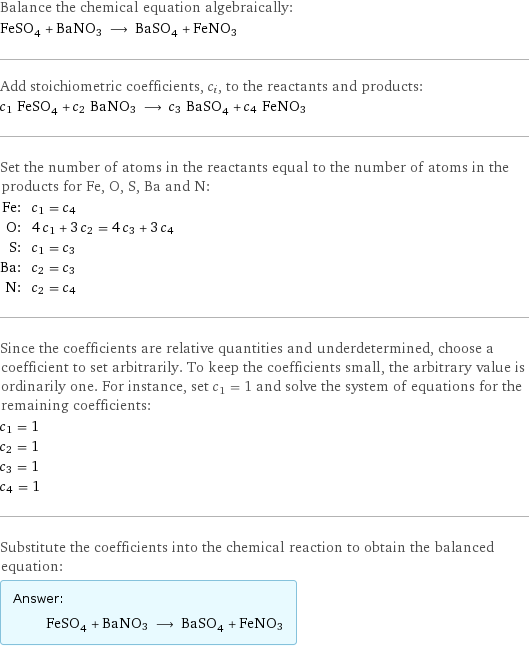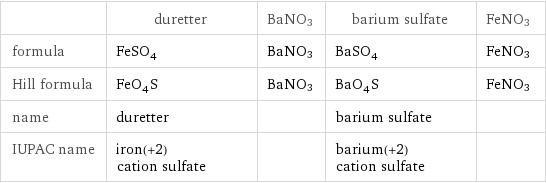Input interpretation

FeSO_4 duretter + BaNO3 ⟶ BaSO_4 barium sulfate + FeNO3
Balanced equation

Balance the chemical equation algebraically: FeSO_4 + BaNO3 ⟶ BaSO_4 + FeNO3 Add stoichiometric coefficients, c_i, to the reactants and products: c_1 FeSO_4 + c_2 BaNO3 ⟶ c_3 BaSO_4 + c_4 FeNO3 Set the number of atoms in the reactants equal to the number of atoms in the products for Fe, O, S, Ba and N: Fe: | c_1 = c_4 O: | 4 c_1 + 3 c_2 = 4 c_3 + 3 c_4 S: | c_1 = c_3 Ba: | c_2 = c_3 N: | c_2 = c_4 Since the coefficients are relative quantities and underdetermined, choose a coefficient to set arbitrarily. To keep the coefficients small, the arbitrary value is ordinarily one. For instance, set c_1 = 1 and solve the system of equations for the remaining coefficients: c_1 = 1 c_2 = 1 c_3 = 1 c_4 = 1 Substitute the coefficients into the chemical reaction to obtain the balanced equation: Answer: | | FeSO_4 + BaNO3 ⟶ BaSO_4 + FeNO3
Structures

+ BaNO3 ⟶ + FeNO3
Names

duretter + BaNO3 ⟶ barium sulfate + FeNO3
Equilibrium constant
![Construct the equilibrium constant, K, expression for: FeSO_4 + BaNO3 ⟶ BaSO_4 + FeNO3 Plan: • Balance the chemical equation. • Determine the stoichiometric numbers. • Assemble the activity expression for each chemical species. • Use the activity expressions to build the equilibrium constant expression. Write the balanced chemical equation: FeSO_4 + BaNO3 ⟶ BaSO_4 + FeNO3 Assign stoichiometric numbers, ν_i, using the stoichiometric coefficients, c_i, from the balanced chemical equation in the following manner: ν_i = -c_i for reactants and ν_i = c_i for products: chemical species | c_i | ν_i FeSO_4 | 1 | -1 BaNO3 | 1 | -1 BaSO_4 | 1 | 1 FeNO3 | 1 | 1 Assemble the activity expressions accounting for the state of matter and ν_i: chemical species | c_i | ν_i | activity expression FeSO_4 | 1 | -1 | ([FeSO4])^(-1) BaNO3 | 1 | -1 | ([BaNO3])^(-1) BaSO_4 | 1 | 1 | [BaSO4] FeNO3 | 1 | 1 | [FeNO3] The equilibrium constant symbol in the concentration basis is: K_c Mulitply the activity expressions to arrive at the K_c expression: Answer: | | K_c = ([FeSO4])^(-1) ([BaNO3])^(-1) [BaSO4] [FeNO3] = ([BaSO4] [FeNO3])/([FeSO4] [BaNO3])](../image_source/a3823974d3c2990d8ea3f6b0fe2379d4.png)
Construct the equilibrium constant, K, expression for: FeSO_4 + BaNO3 ⟶ BaSO_4 + FeNO3 Plan: • Balance the chemical equation. • Determine the stoichiometric numbers. • Assemble the activity expression for each chemical species. • Use the activity expressions to build the equilibrium constant expression. Write the balanced chemical equation: FeSO_4 + BaNO3 ⟶ BaSO_4 + FeNO3 Assign stoichiometric numbers, ν_i, using the stoichiometric coefficients, c_i, from the balanced chemical equation in the following manner: ν_i = -c_i for reactants and ν_i = c_i for products: chemical species | c_i | ν_i FeSO_4 | 1 | -1 BaNO3 | 1 | -1 BaSO_4 | 1 | 1 FeNO3 | 1 | 1 Assemble the activity expressions accounting for the state of matter and ν_i: chemical species | c_i | ν_i | activity expression FeSO_4 | 1 | -1 | ([FeSO4])^(-1) BaNO3 | 1 | -1 | ([BaNO3])^(-1) BaSO_4 | 1 | 1 | [BaSO4] FeNO3 | 1 | 1 | [FeNO3] The equilibrium constant symbol in the concentration basis is: K_c Mulitply the activity expressions to arrive at the K_c expression: Answer: | | K_c = ([FeSO4])^(-1) ([BaNO3])^(-1) [BaSO4] [FeNO3] = ([BaSO4] [FeNO3])/([FeSO4] [BaNO3])
Rate of reaction
![Construct the rate of reaction expression for: FeSO_4 + BaNO3 ⟶ BaSO_4 + FeNO3 Plan: • Balance the chemical equation. • Determine the stoichiometric numbers. • Assemble the rate term for each chemical species. • Write the rate of reaction expression. Write the balanced chemical equation: FeSO_4 + BaNO3 ⟶ BaSO_4 + FeNO3 Assign stoichiometric numbers, ν_i, using the stoichiometric coefficients, c_i, from the balanced chemical equation in the following manner: ν_i = -c_i for reactants and ν_i = c_i for products: chemical species | c_i | ν_i FeSO_4 | 1 | -1 BaNO3 | 1 | -1 BaSO_4 | 1 | 1 FeNO3 | 1 | 1 The rate term for each chemical species, B_i, is 1/ν_i(Δ[B_i])/(Δt) where [B_i] is the amount concentration and t is time: chemical species | c_i | ν_i | rate term FeSO_4 | 1 | -1 | -(Δ[FeSO4])/(Δt) BaNO3 | 1 | -1 | -(Δ[BaNO3])/(Δt) BaSO_4 | 1 | 1 | (Δ[BaSO4])/(Δt) FeNO3 | 1 | 1 | (Δ[FeNO3])/(Δt) (for infinitesimal rate of change, replace Δ with d) Set the rate terms equal to each other to arrive at the rate expression: Answer: | | rate = -(Δ[FeSO4])/(Δt) = -(Δ[BaNO3])/(Δt) = (Δ[BaSO4])/(Δt) = (Δ[FeNO3])/(Δt) (assuming constant volume and no accumulation of intermediates or side products)](../image_source/c544f0b2ce6f4d696eaf56e65d7c6f0e.png)
Construct the rate of reaction expression for: FeSO_4 + BaNO3 ⟶ BaSO_4 + FeNO3 Plan: • Balance the chemical equation. • Determine the stoichiometric numbers. • Assemble the rate term for each chemical species. • Write the rate of reaction expression. Write the balanced chemical equation: FeSO_4 + BaNO3 ⟶ BaSO_4 + FeNO3 Assign stoichiometric numbers, ν_i, using the stoichiometric coefficients, c_i, from the balanced chemical equation in the following manner: ν_i = -c_i for reactants and ν_i = c_i for products: chemical species | c_i | ν_i FeSO_4 | 1 | -1 BaNO3 | 1 | -1 BaSO_4 | 1 | 1 FeNO3 | 1 | 1 The rate term for each chemical species, B_i, is 1/ν_i(Δ[B_i])/(Δt) where [B_i] is the amount concentration and t is time: chemical species | c_i | ν_i | rate term FeSO_4 | 1 | -1 | -(Δ[FeSO4])/(Δt) BaNO3 | 1 | -1 | -(Δ[BaNO3])/(Δt) BaSO_4 | 1 | 1 | (Δ[BaSO4])/(Δt) FeNO3 | 1 | 1 | (Δ[FeNO3])/(Δt) (for infinitesimal rate of change, replace Δ with d) Set the rate terms equal to each other to arrive at the rate expression: Answer: | | rate = -(Δ[FeSO4])/(Δt) = -(Δ[BaNO3])/(Δt) = (Δ[BaSO4])/(Δt) = (Δ[FeNO3])/(Δt) (assuming constant volume and no accumulation of intermediates or side products)
Chemical names and formulas

| duretter | BaNO3 | barium sulfate | FeNO3 formula | FeSO_4 | BaNO3 | BaSO_4 | FeNO3 Hill formula | FeO_4S | BaNO3 | BaO_4S | FeNO3 name | duretter | | barium sulfate | IUPAC name | iron(+2) cation sulfate | | barium(+2) cation sulfate |
Substance properties

| duretter | BaNO3 | barium sulfate | FeNO3 molar mass | 151.9 g/mol | 199.33 g/mol | 233.38 g/mol | 117.85 g/mol phase | | | solid (at STP) | melting point | | | 1345 °C | density | 2.841 g/cm^3 | | 4.5 g/cm^3 | solubility in water | | | insoluble |
Units
